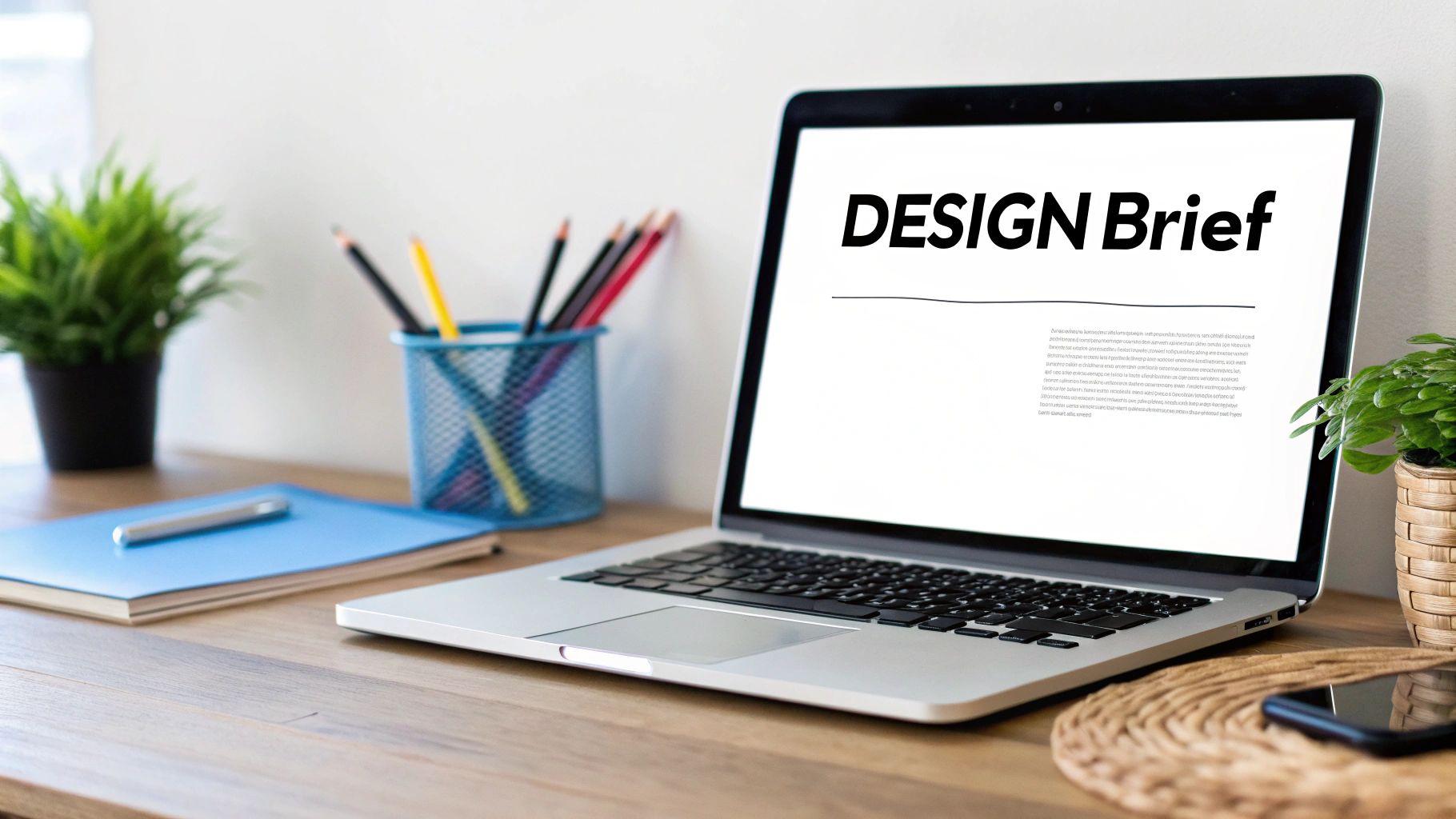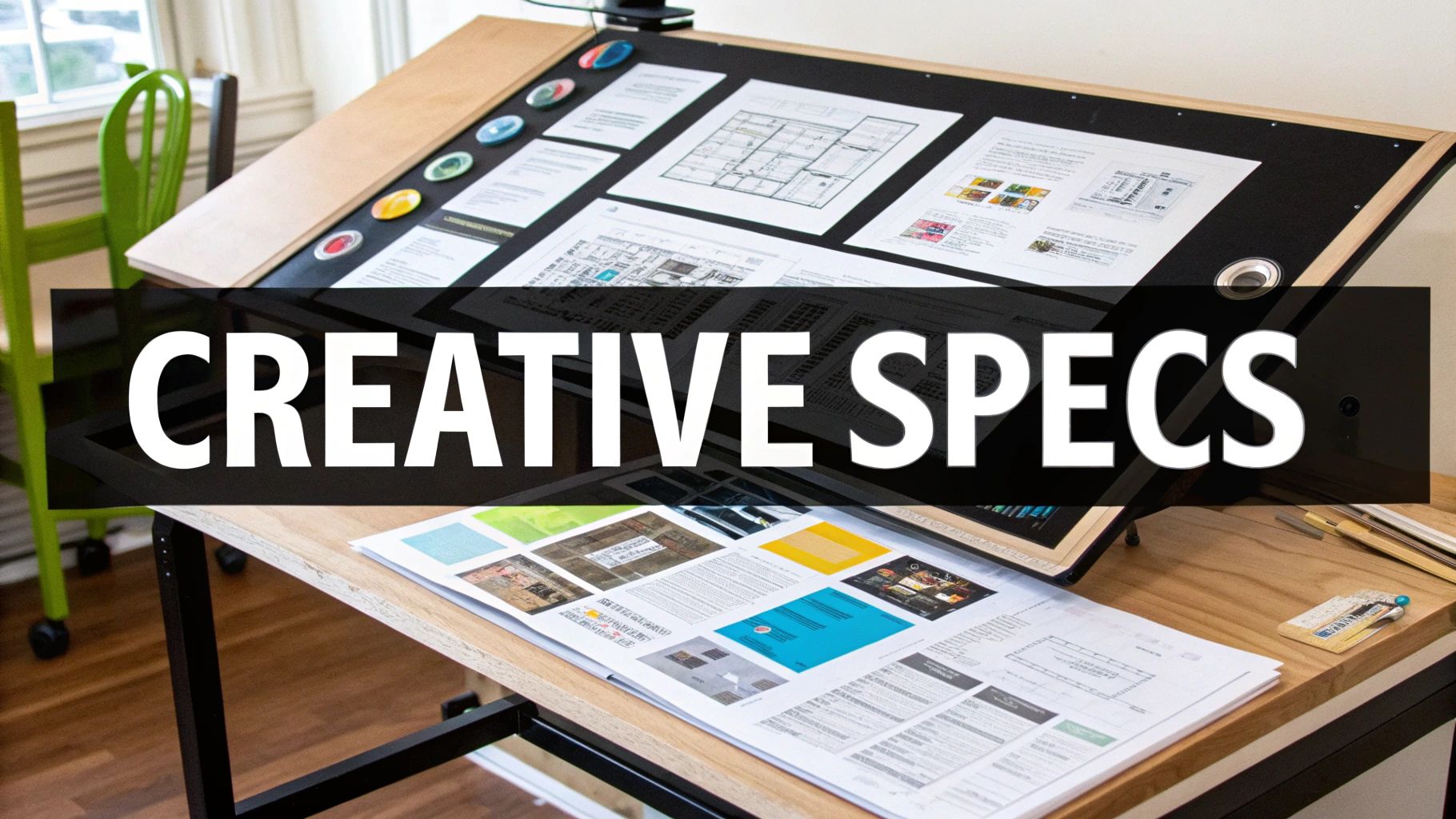Why Design Briefs Make or Break Your Projects

Many design projects fail before they even truly begin. One of the biggest culprits? The absence of a strong design brief. This critical document isn't just paperwork; it's the foundation upon which successful projects are built. It aligns everyone involved and sets the stage for outstanding results. A well-crafted design brief template is a powerful tool for ensuring everyone is on the same page, preventing common project problems. This translates to fewer revisions, less wasted time, and a much smoother process overall.
The Power of Alignment and Clarity
Effective design briefs are more than just a formality. They are crucial communication tools, bridging the gap between the client's vision and the designer's execution. Imagine building a house without blueprints. The result would be chaos, delays, and expensive errors. A design brief serves as the blueprint for your creative project. It provides essential structure and guidance.
It also keeps everyone on the same page, from stakeholders to designers, minimizing misunderstandings and ensuring a unified final product. This clarity fosters a truly collaborative environment, allowing everyone to contribute effectively.
Preventing Project Disasters with Design Briefs
Design briefs proactively prevent scope creep, budget overruns, and missed deadlines. They establish clear boundaries and expectations right from the start, reducing the chance of unexpected additions or changes that can derail a project. A well-defined scope, along with a realistic timeline and budget, enables smarter resource allocation and accurate project management.
This leads to increased efficiency and a higher chance of delivering a successful project on time and within budget. Understanding the history of design briefs is vital when creating a template. They have long been used to align project goals by providing detailed objectives, timelines, and budgets. A well-structured design brief can reduce misunderstandings and project delays by up to 30% simply by clearly defining the project's scope and requirements. Learn more about creating a killer design brief.
From Requirement Lists to Creative Roadmaps
Design briefs have come a long way. They've evolved from simple lists of requirements to dynamic roadmaps that encompass both technical specifications and the overarching artistic vision. This holistic approach ensures the final design not only meets the functional needs but also reflects the client's brand identity and resonates with the target audience.
This guarantees project success by merging creativity with practical considerations. Using a comprehensive design brief template transforms design projects from disorganized struggles into streamlined successes, delivering exceptional results that exceed expectations.
Building Blocks Of Powerful Design Brief Templates
What separates a design brief template that truly works from one that misses the mark is its structure. A strong design brief functions as a blueprint that guides the design process while making sure the client’s vision is matched by the designer’s work. It lays out the framework for discussion and decision making from start to finish.
Project Context And Goals
A design brief should begin by establishing a clear project context. This means outlining the project's purpose, background, and main objectives so that everyone knows the problem to address and what the client wants to achieve. Setting these parameters early on provides clear targets that are Specific, Measurable, Achievable, Relevant, and Time-bound (SMART).
Target Audience And Competitor Analysis
Identifying the target audience is key to creating designs that resonate. A detailed brief asks questions about who the intended users are, their demographics, interests, and challenges. It also emphasizes the need to review competitors by evaluating what they do well and where they fall short. This dual focus helps designers create work that not only fits industry standards but also stands out.
Scope And Deliverables
To steer clear of unwanted changes, a design brief must define the project scope clearly. It spells out what features and elements are included, along with any limitations. Likewise, listing the expected deliverables—whether it’s a logo, website mockup, or a full collection of marketing materials—ensures everyone knows what to expect. Checklists can be beneficial here to maintain consistency and clarity. For example, see this helpful guide: GitHub Pull Request Template Checklist.

Budget And Timeline
Budget and scheduling details are practical components that keep the project grounded. A well-prepared design brief discusses the client’s financial restrictions and outlines key project milestones. A definite timeline that includes allotted time for revisions ensures the work stays on track. Notably, the use of detailed design briefs has become more prevalent over the years. In 2020, roughly 60% of projects started with a detailed brief, and by 2022 that number had grown to over 75%. Find more detailed statistics here.
Below is a table that breaks down the essential components every design brief should include. This table explains the purpose of each element and the key questions designers need to address.
Essential Components Of A Design Brief Template
A comprehensive breakdown of what every effective design brief should include, with explanations of why each element matters
| Component | Purpose | Key Questions To Address |
|---|---|---|
| Project Context And Goals | Establishes the project's purpose and objectives | What problem is being solved? What are the long-term goals? |
| Target Audience And Competitor Analysis | Defines the intended users and assesses market trends | Who is the audience? What are competitors doing right or wrong? |
| Scope And Deliverables | Clarifies project boundaries and expected outputs | What features are included? What specific assets need to be delivered? |
| Budget And Timeline | Sets financial and scheduling expectations | What are the budget constraints? What are the key milestones and deadlines? |
This table encapsulates the building blocks of an effective design brief template, highlighting areas that ensure clarity and mutual understanding.
Combining these structured components results in a tool that not only organizes project details but also helps manage expectations throughout the design journey.
Crafting Client-Focused Design Brief Templates That Deliver

A well-organized design brief template is important, but the truly effective ones do more than cover the basics. They serve as a connection between client ideas—even when those ideas are vague—and clear, actionable instructions for your design team. This client-focused method helps set projects on the right course from the start.
Understanding The Client's Vision: Beyond The Spoken Word
Many clients find it difficult to clearly express what they need. A thoughtful design brief template makes a difference by guiding clients with questions that reach deeper than surface-level answers. For instance, instead of asking, "What do you want?" consider asking, "What feeling do you want your brand to evoke?" This small shift helps clients connect with the emotional core of their project.
Documenting Abstract Concepts: Brand Voice And Visual Identity
It can be tough to capture elements like brand voice and visual identity in clear terms. A solid design brief template provides sections that let you record these hard-to-define ideas. Consider including areas for describing tone, style, and overall appearance along with offering examples or visual references, which help make abstract ideas more concrete for the design team.
Capturing Subjective Elements: Making The Intangible Tangible
Clients frequently have personal tastes and preferences that they struggle to put into words. A well-thought-out template helps bring these feelings into focus by asking targeted questions about imagery preferences, color schemes, and overall mood. For example, asking clients to share inspiring websites or brands can offer valuable insights into their style.
Balancing Accessibility And Technical Detail
A design brief template should feel approachable for those without a design background while still covering all necessary technical points. Using clear and concise language alongside real examples makes the process straightforward for clients. This balance ensures that clients remain comfortable while detailing the essential information needed by your team.
Utilizing Client Questionnaires: Supplementing Your Design Brief Template
To gather even more detailed project information, consider adding client questionnaires. These can explore areas like target audience demographics, competitor analysis, and desired user experience in greater depth. Using questionnaires alongside your main brief provides additional context and helps your design team make well-informed decisions.
Guiding Clients Towards Clarity: Navigating Confusion Effectively
When clients are unsure about their needs, it may lead to delays and miscommunications. A thoughtfully crafted design brief template can help clarify their ideas with clear instructions, useful examples, and strategically placed tooltips. These elements provide the support necessary for clients to share their thoughts clearly, ensuring that your team has all the details required to move forward confidently.
Industry-Specific Design Brief Templates That Win Clients

Generic design brief templates often miss the mark when it comes to the unique needs of different industries. A one-size-fits-all approach can lead to missed opportunities and a final product that simply doesn't resonate with the intended audience. Creating a tailored design brief template is essential for winning clients and ensuring project success.
E-Commerce: Conversion-Focused Design
In the fast-paced e-commerce world, design briefs should prioritize conversion rate optimization. Key questions revolve around user experience, product presentation, and the checkout process.
Understanding how users navigate a site and find calls to action is crucial. This conversion-driven focus ensures the design contributes to the client's bottom line.
Healthcare: Accessibility and Compliance
Healthcare design briefs demand a deep understanding of accessibility guidelines and regulatory compliance. Considerations for visually impaired users, clear information hierarchy, and HIPAA compliance are paramount.
This means incorporating features like alt text for images and safeguarding patient data privacy. These elements build trust and show a commitment to ethical design.
Education: Engaging and Inclusive Learning
Educational design briefs must emphasize engagement and inclusivity. Understanding different learning styles and creating accessible content for diverse learners is critical.
Incorporating interactive elements and offering multiple formats for information can significantly improve learning outcomes.
Nonprofits: Communicating Mission and Impact
Nonprofit design briefs need to clearly communicate the organization's mission and impact. Focusing on storytelling, emotional connection, and calls to action becomes crucial.
This approach raises awareness, engages donors, and drives support for the cause. Clearly articulating the organization’s values strengthens the overall message.
B2B: Building Trust and Professionalism
B2B design briefs require a strong focus on establishing trust and professionalism. Understanding the client's brand identity, target audience, and competitive landscape is essential.
This involves incorporating elements that reflect the client's expertise and industry leadership, creating a solid brand presence, and fostering long-term business relationships.
Managing Multi-Purpose Projects
Projects that span multiple industries don't necessarily require overly complex documentation. Focus on the core requirements shared by all sectors involved.
For example, a project combining e-commerce and B2B elements might prioritize both user experience and brand professionalism. This approach streamlines the briefing process. By making subtle adjustments to your template, you show clients you understand their specific needs and opportunities.
To further illustrate these considerations, let's examine a comparison table highlighting the nuances of crafting design briefs across various industries:
Industry-Specific Design Brief Considerations
| Industry | Key Focus Areas | Special Considerations | Common Pitfalls |
|---|---|---|---|
| E-Commerce | Conversion rate optimization, user experience, product display | Checkout process, mobile responsiveness | Neglecting user experience, unclear calls to action |
| Healthcare | Accessibility, regulatory compliance, clear information | HIPAA compliance, patient privacy | Inaccessible design, complex language |
| Education | Engagement, inclusivity, diverse learning styles | Interactive elements, multiple content formats | Passive learning experiences, exclusionary design |
| Nonprofits | Communicating mission and impact, storytelling | Emotional connection, calls to action | Generic messaging, unclear impact reporting |
| B2B | Trust, professionalism, brand identity | Target audience understanding, competitive analysis | Lack of differentiation, overlooking brand consistency |
This table highlights the unique requirements and potential challenges within each sector. By understanding these nuances, you can craft design briefs that resonate with clients and pave the way for project success.
Digital Tools That Transform Your Design Brief Process
Creating a solid design brief template is a crucial first step. However, managing those templates, working with clients, and weaving them into your current workflow requires the right digital tools. Thankfully, you have a variety of options, each with its own set of advantages and disadvantages. Choosing the best fit for your needs will significantly improve your design process.
Specialized Design Brief Applications
Some platforms are built specifically for creating and managing design briefs. These applications offer helpful features like template customization, client collaboration portals, and version control. This specialized focus helps ensure that all the necessary information is collected and readily available. These tools can simplify the briefing process for everyone, from the designer to the client.
Project Management Systems
You can often adapt existing project management platforms to handle design brief templates. Systems like Asana, Trello, or Monday.com offer features for task management, file sharing, and communication. This integration directly connects your design brief to the project workflow. For instance, you can link tasks directly to specific sections within the brief itself.
Collaborative Document Tools
Cloud-based document platforms like Google Docs and Microsoft Word online offer a familiar interface for collaborative brief development. These tools enable real-time co-editing and commenting, which is especially useful when working closely with clients to refine the design brief. However, they may lack the specialized functions found in dedicated design brief platforms.
CRM Integrations
Integrating your design brief process with your Customer Relationship Management (CRM) system brings valuable client data to the table. This data-driven approach ensures personalized design briefs tailored to each client's specific needs. Access to past project history within the CRM, for example, can inform current brief development. This integration helps create more impactful design brief templates.
Choosing the Right Tools for Your Workflow
The right tool depends on factors like team size, budget, and current tech stack. A small team might find collaborative document tools sufficient, while a larger agency could benefit from a dedicated design brief platform or CRM integration. Consider template customization, client collaboration features, approval workflows, and integration capabilities when evaluating each option. By carefully selecting the right tools, you can build a seamless design brief process that connects with other project documentation and maintains version control. This ultimately saves time and resources by preventing miscommunication and streamlining the entire process.
Turning Great Briefs Into Exceptional Project Outcomes
A well-crafted design brief template is like a finely tuned instrument. It needs the right player and the right setting to truly shine. Simply having a template isn't enough. Successful implementation is key to unlocking its full potential. This involves getting buy-in from both clients and team members, ensuring consistent use, and adapting the template to each project’s unique circumstances.
Overcoming Resistance and Fostering Adoption
Introducing a new process, even one with obvious advantages, can sometimes meet with resistance. Clients might view a detailed design brief as unnecessary paperwork. Team members might resist changing established routines. Addressing these concerns directly is crucial for successful adoption.
Clearly explaining the purpose and benefits of the design brief template can help clients understand its value. For instance, demonstrating how a thorough brief leads to fewer revisions and a faster turnaround can be very persuasive. Similarly, providing training and support to team members ensures everyone feels comfortable using the new template.
Establishing Effective Review and Accountability Systems
Catching incomplete information early in the design process saves significant time and resources down the line. This means establishing clear review protocols. Both client-provided information and internal interpretations should be checked for completeness.
Creating an accountability system ensures that projects stay true to the design brief’s specifications throughout the entire design lifecycle. This might involve regular check-ins to confirm alignment with the brief or a formal sign-off process at each key project stage. This helps keep everyone on the same page and minimizes potential misunderstandings.
Addressing Shifting Requirements and Maintaining Flexibility
Design projects rarely follow a straight line. Client needs can change, or unforeseen technical challenges might arise. Using your design brief template as a “living document” allows teams to adapt to these changes while staying grounded in the original vision.
This adaptability can be facilitated by tools that allow for version control and collaboration, such as Google Docs or Microsoft SharePoint. These platforms enable everyone to stay informed as the design brief evolves. Cloud-based documentation allows clients and the design team to track adjustments and provide real-time feedback.
Using Your Design Brief Template for Continuous Improvement
Just as design projects evolve, so should your design brief template. Regularly collecting feedback from both clients and team members offers valuable insights for improvement. This feedback loop could involve simple surveys or more in-depth discussions about the template’s effectiveness.
By consistently refining your design brief template, you maximize its ability to drive positive project outcomes and elevate the design process. This creates a dynamic system where your template continually improves, leading to more efficient and successful projects. This commitment to continuous improvement strengthens client relationships, streamlines workflow, and produces exceptional results.
Measuring the ROI of Your Design Brief Templates
How can you determine the effectiveness of your design brief template? It requires more than just intuition. You need concrete data to showcase the impact of a well-crafted template. This involves tracking key performance indicators and gathering feedback for ongoing improvement.
Key Metrics for Evaluating Template Effectiveness
Successful design leaders value data-driven decisions. They measure the ROI of their design brief templates by tracking important metrics.
-
Reduced Revision Requests: Fewer revisions translate to less wasted time and resources, directly impacting project timelines and budgets. A good design brief ensures everyone is aligned from the beginning, minimizing back-and-forth later.
-
Improved Client Satisfaction Scores: Satisfied clients are more likely to return for future projects and recommend your services. A well-defined design brief demonstrates your commitment to understanding their needs.
-
Decreased Project Timelines: When everyone works from the same plan, projects progress smoothly and efficiently. A clear brief minimizes confusion and delays, keeping projects on track.
-
Enhanced Team Alignment: A shared understanding of project goals and deliverables fosters better collaboration and communication within the design team. A strong brief acts as a central point of reference, ensuring everyone works towards the same objective.
Gathering Actionable Feedback: The Key to Continuous Improvement
A feedback system is essential. This means actively seeking input from both your internal design team and your clients. Ask specific questions about the clarity, completeness, and usability of the template.
Internal Team Feedback
Ask your designers about their experience with the template. Did it provide the necessary information to begin the project effectively? Was it easy to understand and complete?
Client Feedback
Client perspectives are equally vital. Did the brief capture their vision and expectations? Was the process of completing it clear and straightforward?
Regularly collecting and analyzing feedback helps identify areas for improvement and refine your template. Schedule periodic reviews to assess its effectiveness and make necessary adjustments. This continuous improvement process ensures your template remains a valuable asset.
Quantifying Success: Real-World Examples of Template Impact
Real-world cases highlight the impact of effective design brief templates. Consider a design agency struggling with project delays due to unclear client communication. After implementing a structured template, they achieved a 20% reduction in project turnaround time and significantly increased client satisfaction.
Another example involves a freelance designer overwhelmed with revisions. A more detailed design brief template helped reduce revisions by 15%, freeing up time for other work.
These results demonstrate the significant impact of a well-designed template. It's not just about creating a document; it's about building a foundation for project success.
Ready to improve your design process and connect with skilled creative talent? Visit Creativize to discover a network of professionals and resources for your next project.

